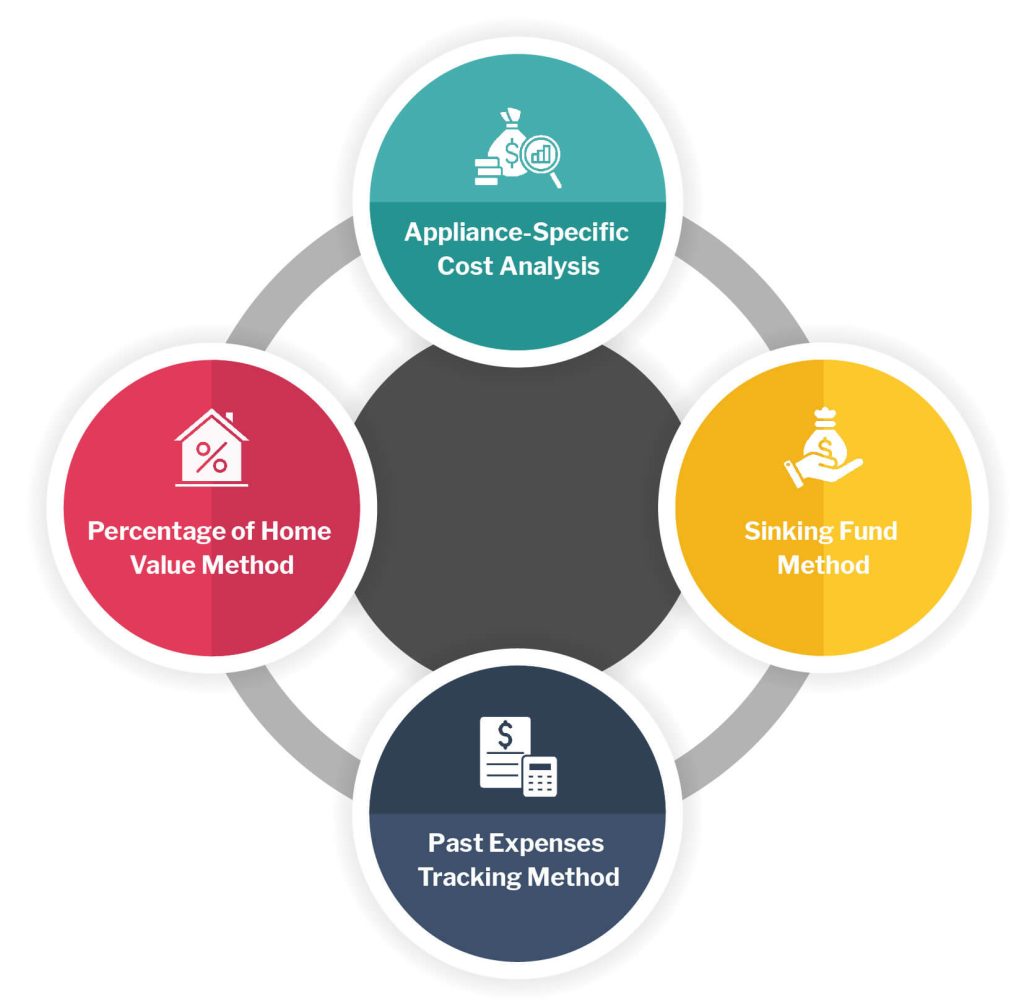 Last updated: August 8th, 2024
Last updated: August 8th, 2024
Appliance Repair Costs: How To Build A Maintenance Budget For Financial Stability

Modern appliances are engineering marvels, silently toiling away to keep our homes comfortable and functional. But like any machine, they are susceptible to breakdowns. While preventative maintenance can extend lifespans, unexpected repairs are a reality. This article explores various budgeting strategies, incorporating a technical understanding of appliance repair costs to help you through expenses from unforeseen breakdowns.
The Cost Conundrum: The Challenge of Budgeting for Appliance Repairs
Predicting the exact cost of an appliance repair is challenging. It depends on several factors:
- Appliance Type: Repair costs vary significantly between different appliances. A simple toaster repair might cost less than $100, while a major component failure in a high-end refrigerator can reach upwards of $1,000. Here is a table that shows the cost of repair and replacement of some common issues plaguing our appliances:
|
Appliance Category |
Common Repairs |
Repair Cost Range (USD) |
Replacement Cost Range (USD) |
|
Refrigerator |
Compressor Failure |
$500 – $1,200 |
$1,500 – $2,000 |
|
Faulty Defrost System |
$150 – $400 |
$500 – $600 |
|
|
Leaking Refrigerant |
$100 – $500 |
$200 – $700 |
|
|
Washer & Dryer |
Faulty Motor |
$300 – $800 |
$800 – $1,200 |
|
Broken Belt Or Drive System |
$100 – $300 |
$200 – $400 |
|
|
Leaking Issues |
$100 – $400 |
$300 – $700 |
|
|
Oven & Range |
Faulty Heating Element |
$100 – $300 |
$150 – $400 |
|
Malfunctioning Control Board |
$150 – $500 |
$200 – $700 |
|
|
Faulty Oven Door Seal |
$50 – $150 |
$100 – $200 |
|
|
Dishwasher |
Clogged Drain Pump |
$100 – $200 |
$200 – $400 |
|
Faulty Circulation Pump |
$150 – $300 |
$300 – $500 |
|
|
Broken Door Latch |
$50 – $150 |
$100 – $250 |
|
|
Microwave |
Faulty Magnetron |
$200 – $400 |
$250 – $500 |
|
Broken Door Switch |
$50 – $100 |
$75 – $150 |
|
|
Transformer Issues |
$100 – $200 |
$150 – $300 |
|
|
Garbage Disposal |
Jammed Blades |
$50 – $150 |
$50 – $300 |
|
Leaking Unit |
$100 – $300 |
$100 – $400 |
|
|
Freezer (Standalone) |
Faulty Compressor |
$300 – $800 |
$800 – $1,500 |
|
Faulty Defrost System |
$100 – $300 |
$200 – $600 |
|
|
Leaking Refrigerant |
$100 – $400 |
$300 – $800 |
|
|
Cooktop (Separate Cooktop) |
Faulty Heating Element |
$100 – $300 |
$150 – $400 |
|
Faulty Control Panel |
$150 – $400 |
$300 – $800 |
- Appliance Variability: Repair costs differ significantly across appliances. A simple toaster repair might cost less than $100, while a major component failure in a high-end refrigerator can reach upwards of $1,000.
- The Severity Of The Issue: Minor issues like faulty switches or clogged filters are generally less expensive than malfunctioning compressors or cracked heating elements.
- Labor Rates: Labor rates are a significant factor in the cost problem of budgeting for appliance repair. Here’s how they contribute to the challenge:
- Uncertainty: Unlike parts costs, which can be researched online or obtained from appliance manufacturers, labor rates can vary greatly depending on several factors. This makes it difficult to predict the exact repair cost upfront.
- Regional Variations: Labor rates can differ significantly between states, urban and rural areas, and even between individual service providers. This creates uncertainty when budgeting for repairs, as the cost can fluctuate depending on your location.
- Complexity Of Repair: Labor rates often increase with the complexity of the repair. Diagnosing the issue, accessing certain components within the appliance, and replacing intricate parts can require more time and expertise from the technician, leading to higher labor costs.
- Impact on Budgeting: Due to the uncertainty surrounding labor rates, allocating a precise amount in your budget for potential repairs is challenging. This can lead to financial strain if a major appliance breaks down and the repair cost exceeds your expectations.
Data-Driven Budgeting Strategies For Appliances Maintenance
Here are four prominent approaches to budgeting for unexpected appliance repair costs, incorporating insights from industry data:

1. Percentage of Home Value Method
The percentage of home value method is a straightforward strategy for budgeting for unexpected appliance repairs. It leverages the idea that the cost of maintaining a home scales proportionally with its value. Here’s a detailed breakdown of this method:
– Core Principle
This method assumes that a home’s value reflects its maintenance cost, including potential repairs for appliances and other components.
– Implementation
- Determine Your Home’s Value: This could be your home’s current market value or the assessed value from your property tax records.
- Choose A Percentage Range: The common range for this method is 1% to 3% of your home’s value annually.
- 1%: This is a conservative estimate, suitable for newer homes with fewer appliances or a history of reliable performance.
- 3%: This is a more cautious approach, ideal for older homes with many appliances or a history of frequent breakdowns.
– Calculation
Multiply your home’s value by the chosen percentage to determine your annual appliance repair and maintenance budget allocation.
Annual Budget Allocation
$Example:
- Home Value: $400,000
- Chosen Percentage: 2%
Annual Budget Allocation: $400,000 (home value) x 2% = $8,000
– Benefits Of The Percentage Of Home Value Method
- Simplicity: This method is incredibly easy to implement. You can establish a basic repair budget using your home’s value and a chosen percentage.
- Peace Of Mind: Allocating a specific repair budget can provide peace of mind, knowing you have funds set aside if an appliance breaks down unexpectedly.
- Scalability: This method automatically adjusts your repair budget as your home value increases. This can account for inflation and more expensive repairs in larger homes.
– Limitations Of The Percentage Of Home Value Method
- Lack Of Specificity: This method doesn’t account for the specific types of appliances you own or their individual repair costs. A high-end oven repair might be significantly more expensive than a basic toaster repair. This lack of specificity can lead to:
- Over-Budgeting: For homes with fewer appliances or a history of reliable appliances, allocating 1-3% of their home value might be excessive.
- Under-Budgeting: 1-3% of the home value might not be enough to cover all potential repair costs for homes with many appliances or a history of frequent breakdowns.
2. Appliance-Specific Cost Analysis
Unexpected appliance breakdowns can wreak havoc on your finances. Traditional budgeting methods often struggle with the uncertainty of repair costs. This is where appliance-specific cost analysis comes in. This detailed approach empowers you to create a more targeted and personalized budget for potential appliance repairs.
– The Power Of Specificity
Unlike the percentage of home value method, appliance-specific cost analysis focuses on the unique characteristics of your situation. Here’s how it works:
- Inventory Your Appliances: Create a list of all the major appliances in your home, including their age, brand, and model.
- Research Common Repair Issues: Research common repair problems for each appliance. Reliable resources include:
- Appliance manufacturer websites
- Online appliance repair forums
- Local service provider websites
- Estimate Repair Costs: Find the average repair cost range for each common repair issue identified in Step 2. Utilize online resources and quotes from local service providers for accurate estimates.
– Benefits of Appliance-Specific Cost Analysis
- Targeted Budgeting: This method allows you to allocate funds more strategically based on the specific appliances you own and their repair vulnerabilities.
- Informed Decision-Making: Knowing the potential repair costs for each appliance empowers you to make informed decisions in the event of a breakdown. Based on your budget allocation, you can weigh the repair cost against the cost of replacement.
- Improved Financial Preparedness: By creating a targeted budget, you’ll be better prepared to handle unexpected repairs without derailing your other financial goals.
– Considerations And Limitations
- Research Effort: This method requires more upfront research than the percentage of home value method.
- Accuracy: Repair cost estimates are averages and may not reflect the exact cost of a specific repair.
- Unforeseen Issues: This method doesn’t account for unforeseen breakdowns beyond common repairs.
3. Sinking Fund Method
Unexpected appliance breakdowns are a fact of life, and their repair costs can significantly impact your finances. Traditional budgeting methods often struggle with the uncertainty of these expenses. The sinking fund method offers a systematic and proactive approach to ensure you’re financially prepared when your appliances need attention.
– The Core Concept
The sinking fund method involves setting aside a fixed amount of money monthly into a dedicated savings account specifically for appliance repair costs. This approach allows you to accumulate funds gradually, creating a financial buffer for those inevitable repairs.
– Implementation Steps
- Estimate Appliance Lifespan: Research the average lifespan of your major appliances (refrigerators, ovens, washing machines, etc.). Appliance manufacturer websites and consumer reports can be valuable resources for this information.
- Estimate Repair Costs: Research the average repair costs for common issues affecting each appliance you own. Utilize online resources, appliance manufacturer websites, and quotes from local service providers for accurate estimates.
- Calculate Monthly Contribution: Here’s the formula to determine your monthly contribution amount:
Annual Budget Allocation
$Monthly Contribution = (Estimated Yearly Repair Cost) x (Appliance Lifespan In Years) / (Appliance Lifespan In Months)
For example, if an appliance has an average lifespan of 10 years and the average repair cost is $500, your monthly contribution would be:
Monthly Contribution = ($500 *10) / (120 months) = $41.67/month for the appliance. This has to be calculated for all the appliances at home to be sufficiently prepared.
– Benefits of the Sinking Fund Method
- Systematic Saving: This method promotes consistent saving, even for irregular expenses like appliance repairs.
- Financial Preparedness: By steadily accumulating funds, you’ll be better equipped to handle unexpected repair costs without derailing your overall budget.
- Peace Of Mind: Knowing you have a dedicated fund for repairs can provide peace of mind and reduce financial stress in the event of a breakdown.
– Considerations & Limitations
- Research Effort: This method requires initial research to estimate appliance lifespans and repair costs.
- Accuracy: Estimated lifespans and repair costs might not reflect the exact realities of your situation. Unexpected breakdowns or major repairs beyond the average cost can strain the fund.
- Discipline Required: The success of this method hinges on consistent monthly contributions.
4. Past Expenses Tracking Method
Unexpected appliance breakdowns are a homeowner’s reality. Budgeting for these repairs can be challenging due to the variability of repair costs. The Track Past Expenses Method offers a data-driven approach that leverages your financial history to create a personalized repair budget.
– Leveraging Your Spending Data
This method analyzes your past spending on appliance repairs to predict future needs and establish a targeted budget. Here’s how to implement it:
- Gather Your Records: Collect documentation related to past appliance repairs in your home. This might include receipts, bank statements, or entries in a budgeting app.
- Identify Repair Costs: Review the collected records and identify the cost of each past repair. Categorize the repairs by appliance (e.g., refrigerator repair, oven repair).
- Calculate Average Yearly Cost: Add up the total cost of repairs from your records. Divide this sum by the years your data covers to determine your average yearly repair cost.
– Building Your Budget
With your average yearly cost established, you can translate it into a practical budgeting strategy:
- Allocate Funds: Based on your average yearly repair cost, allocate a specific amount in your monthly budget for potential appliance repairs. You can add a buffer of 10-20% to account for potential fluctuations in repair costs.
- Review & Update: Review your repair budget periodically, ideally annually. As your appliances age, the likelihood and cost of repairs might increase. Adjust your budget allocation accordingly.
- Consider Appliance Age: Factor in the age of your appliances. As appliances age, the average yearly cost you calculated might need to be adjusted upwards to reflect the higher likelihood of repairs.
– Benefits Of The Track Past Expenses Method
- Personalized Approach: This method leverages your spending history, providing a budget tailored to your specific situation and appliance repair needs.
- Data-Driven Insights: Analyzing past expenses can provide valuable insights into the historical cost of maintaining your appliances.
- Improved Financial Preparedness: A dedicated repair budget helps you be financially prepared for unexpected breakdowns, preventing them from derailing your overall financial goals.
– Considerations And Limitations
- Limited Data: If you haven’t owned your home for long or have a limited repair history, this method might not provide enough data for an accurate prediction.
- Unforeseen Issues: This method focuses on past repairs and might not account for unforeseen breakdowns beyond what you’ve experienced previously.
- Changing Costs: Repair costs can fluctuate over time due to inflation or changes in service provider rates. Your past data might not perfectly reflect future costs.
Beyond Budgeting: Additional Considerations
- Emergency Fund: A robust emergency fund is crucial for unexpected expenses beyond appliance repairs. Aim for 3-6 months of living expenses to cover various contingencies.
- Home Warranty: Consider a home warranty that covers repairs for major appliances in case of breakdown. Carefully review the warranty terms, exclusions, and coverage limits before purchasing.
- DIY vs. Professional Repair: For some handy homeowners, attempting DIY repairs can be a cost-effective option for minor issues. However, weigh the potential risks of causing further damage against the potential savings.
Home Warranty Plans And Appliances Repair Cost Budgeting
Appliance breakdowns are inevitable, and the repair costs can wreak havoc on your budget. Home warranties offer a potential solution, functioning as a safety net against unexpected repair expenses. Here’s a breakdown of how they impact budgeting and their pros and cons.
Budgeting With A Home Warranty
- Fixed Cost: Unlike unpredictable repair bills, a home warranty has a fixed annual or monthly cost. This allows you to factor the warranty premium into your regular budget, promoting better financial planning for appliance repairs.
- Peace Of Mind: Knowing you have repair coverage can alleviate stress and anxiety associated with potential breakdowns. Budgeting becomes less stressful when you have a defined cost for repairs.
Benefits of Home Warranties
- Predictable Costs: Fixed premiums provide predictable budgeting compared to potentially high and unexpected repair bills.
- Coverage For Major Appliances: Warranties typically cover repairs or replacements for major appliances like refrigerators, ovens, dishwashers, washing machines, and dryers. This protects you from the financial burden of repairing or replacing these essential appliances.
- Discounted Repairs: Home warranty companies often have negotiated rates with service providers, potentially leading to lower repair costs than what you might pay on your own.
- Convenience: Home warranties often handle scheduling appointments with qualified service providers, saving you time and hassle.
Drawbacks of Home Warranties
- Coverage Exclusions: Warranties typically exclude specific repairs, pre-existing conditions, normal wear and tear, and cosmetic damage. Carefully review the warranty terms and exclusions to understand what’s covered.
- Limited Coverage Amounts: Warranties might have coverage limits per appliance or per repair. You might need to pay additional costs exceeding these limits.
- Potential For Claim Denials: Warranties might deny coverage for certain repairs based on various clauses in the fine print. Thoroughly understand the claims process to avoid unexpected denials.
- Not A Substitute For Maintenance: Home warranties don’t replace preventative maintenance. Regularly maintaining your appliances can extend their lifespan and reduce the need for repairs covered under the warranty.
Is a Home Warranty Right for You?
The decision to purchase a home warranty depends on your circumstances and risk tolerance:
- Frequent Breakdowns: A warranty can provide financial protection and peace of mind if you have a history of frequent appliance breakdowns.
- Older Appliances: Homes with older appliances are more prone to breakdowns, making a warranty a potentially valuable investment.
- Budget Constraints: If you’re on a tight budget and unexpected repair costs would be a significant financial strain, a warranty can provide predictability.
- Do-It-Yourself Expertise: A warranty might not be necessary if you’re comfortable repairing appliances.
Maximizing the Benefits of a Home Warranty
- Compare Plans and Providers: Research different home warranty companies and plans to find one that fits your needs and budget.
- Read the Fine Print: Before purchasing, carefully review the warranty terms, exclusions, coverage limits, and claims process.
- Maintain Your Appliances: Regular maintenance is crucial even with a warranty. It can extend appliance life and potentially prevent warranty claim denials.
Final Word
By incorporating these budgeting strategies and considering the technical aspects of appliance repair costs, you can gain greater control over your home maintenance expenses. Remember, a proactive approach to budgeting protects you from financial strain in the face of an unexpected appliance breakdown, ensuring your home continues to function smoothly and efficiently.
related articles
 Discover First American Home Warranty Locations and What You Need to Know About Their Cover.
Discover First American Home Warranty Locations and What You Need to Know About Their Cover.
 Reviews of Home Warranty Companies Show You How to Determine If Your Home Is Covered
Reviews of Home Warranty Companies Show You How to Determine If Your Home Is Covered











